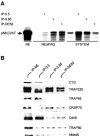Novel critical role of a human Mediator complex for basal RNA polymerase II transcription
- PMID: 11559591
- PMCID: PMC1084041
- DOI: 10.1093/embo-reports/kve186
Novel critical role of a human Mediator complex for basal RNA polymerase II transcription
Abstract
Human Mediator complexes have been described as important bridging factors that enhance the effect of activators in purified systems and in chromatin. Here we report a novel basal function of a human Mediator complex. A monoclonal antibody was generated that depleted the majority of Mediator components from crude cell extracts. The removal of human Mediator abolished transcription by RNA polymerase II. This was observed on all genes tested, on TATA-containing and TATA-less promoters, both in the presence and absence of activators. To identify the relevant complex a combined biochemical and immunopurification protocol was applied. Two variants termed Mediator and basal Mediator were functionally and structurally distinguished. Basal Mediator function relies on additional constraints, which is reflected in the observation that it is essential in crude but not in purified systems. We conclude that basal Mediator is a novel general transcription factor of RNA polymerase II.
Figures




Similar articles
-
Basal components of the transcription apparatus (RNA polymerase II, TATA-binding protein) contain activation domains: is the repetitive C-terminal domain (CTD) of RNA polymerase II a "portable enhancer domain"?Mol Reprod Dev. 1994 Oct;39(2):215-25. doi: 10.1002/mrd.1080390215. Mol Reprod Dev. 1994. PMID: 7826625
-
The new core promoter element XCPE1 (X Core Promoter Element 1) directs activator-, mediator-, and TATA-binding protein-dependent but TFIID-independent RNA polymerase II transcription from TATA-less promoters.Mol Cell Biol. 2007 Mar;27(5):1844-58. doi: 10.1128/MCB.01363-06. Epub 2007 Jan 8. Mol Cell Biol. 2007. PMID: 17210644 Free PMC article.
-
Identification of a minimal set of proteins that is sufficient for accurate initiation of transcription by RNA polymerase II.Genes Dev. 1993 Jul;7(7A):1254-65. doi: 10.1101/gad.7.7a.1254. Genes Dev. 1993. PMID: 8319911
-
Mediator of transcriptional regulation.Trends Biochem Sci. 1996 Sep;21(9):335-7. doi: 10.1016/s0968-0004(96)10051-7. Trends Biochem Sci. 1996. PMID: 8870496 Review.
-
The mediator of RNA polymerase II.Chromosoma. 2005 Mar;113(8):399-408. doi: 10.1007/s00412-005-0329-5. Epub 2005 Feb 3. Chromosoma. 2005. PMID: 15690163 Review.
Cited by
-
Structural and functional characterization of PC2 and RNA polymerase II-associated subpopulations of metazoan Mediator.Mol Cell Biol. 2005 Mar;25(6):2117-29. doi: 10.1128/MCB.25.6.2117-2129.2005. Mol Cell Biol. 2005. PMID: 15743810 Free PMC article.
-
Disordered proteinaceous machines.Chem Rev. 2014 Jul 9;114(13):6806-43. doi: 10.1021/cr4007329. Epub 2014 Apr 4. Chem Rev. 2014. PMID: 24702702 Free PMC article. Review. No abstract available.
-
Importance of Mediator complex in the regulation and integration of diverse signaling pathways in plants.Front Plant Sci. 2015 Sep 17;6:757. doi: 10.3389/fpls.2015.00757. eCollection 2015. Front Plant Sci. 2015. PMID: 26442070 Free PMC article. Review.
-
Novel role for mediator complex subunit Srb5/Med18 in termination of transcription.J Biol Chem. 2011 Oct 28;286(43):37053-7. doi: 10.1074/jbc.C111.295915. Epub 2011 Sep 14. J Biol Chem. 2011. PMID: 21921038 Free PMC article.
-
TRAP/SMCC/mediator-dependent transcriptional activation from DNA and chromatin templates by orphan nuclear receptor hepatocyte nuclear factor 4.Mol Cell Biol. 2002 Aug;22(15):5626-37. doi: 10.1128/MCB.22.15.5626-5637.2002. Mol Cell Biol. 2002. PMID: 12101254 Free PMC article.
References
-
- Abraham S. and Solomon, W.B. (2000) A novel glutamine-rich putative transcriptional adaptor protein (TIG-1), preferentially expressed in placental and bone-marrow tissues. Gene, 255, 389–400. - PubMed
-
- Akoulitchev S., Chuikov, S. and Reinberg, D. (2000) TFIIH is negatively regulated by cdk8-containing mediator complexes. Nature, 407, 102–106. - PubMed
-
- Berti L. et al. (2001) Isolation and characterization of a novel gene from the DiGeorge chromosomal region that encodes for a Mediator subunit. Genomics, 74, 320–332. - PubMed
-
- Boyer T.G., Martin, M.E., Lees, E., Ricciardi, R.P. and Berk, A.J. (1999) Mammalian Srb/Mediator complex is targeted by adenovirus E1A protein. Nature, 399, 276–279. - PubMed
-
- Flanagan P.M., Kelleher, R.J., Sayre, M.H., Tschochner, H. and Kornberg, R.D. (1991) A mediator required for activation of RNA polymerase II transcription in vitro. Nature, 350, 436–438. - PubMed
Publication types
MeSH terms
Substances
LinkOut - more resources
Full Text Sources
Other Literature Sources
Molecular Biology Databases

